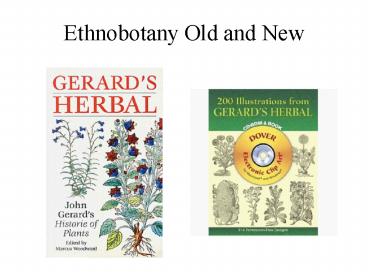Ethnobotany Old and New - PowerPoint PPT Presentation
1 / 42
Title: Ethnobotany Old and New
1
Ethnobotany Old and New
2
Ginseng root Panax pseudoginseng
3
Foxglove Digitalis purpurea
- Foxglove may be useful as a way to cure people of
grosse and slimie flegme and naughtie humors
from Gerards Herbal - 1597
4
William Withering - holding a foxglove
5
Witherings work on Foxglove
- Began experiments with foxglove in 1775 -
Withering had heard about an old family cure for
dropsy - Reported his findings in a paper published in
1785, An Account of the Foxglove and Some of its
Medical Uses - Powdered foxglove leaf is still prescribed in
tablets or capsules to treat congestive heart
failure - The somewhat crude powdered drug is called
Digitalis after the plant - Foxglove produces more than 30 different cardiac
glycosides - two in particular - Digoxin and
Digitoxin are produced from foxglove and
prescribed to heart patients around the world
today
6
Linneaus in Sami clothing
7
Linneaus pioneered techniques that are basic to
ethnobotanists practicing today
- 1. He traveled alone or with only a few
companions to distant lands with a minimum of
gear - 2. In the field Linneaus ate indigenous foods
and learned to use plants as the indigenous
people used them - 3. Linneaus developed a deep rapport with the
people he lived with and studied
8
Richard Schultes, Kiowa Roadman Belo Kozad, and
Weston La Barre 1936, Oklahoma
9
Lophophora williamsii peyote cactus
10
Richard Schultes Amazonia, late 1940s
11
Tagetes lucida Mexican hallucinogenic marigold
12
Two Great Challenges for Ethnobotanists Today
- 1. We still must catalog what is known about
plants, document which plants are and are not
important to a society, and recording the vast
amount of folk beliefs about different plant
species.
13
Two Great Challenges for Ethnobotanists Today
- 2. An even more difficult task is to understand
not just how a particular group uses plants but
how that group perceives plants, how it
interprets those perceptions, how those
perceptions influence the behavior of that
society, and how those activities and behaviors
influence the plants and ecosystem upon which the
society depends.
14
Origin of Domesticated Plants
Wheat
15
Most domesticated food plants have been selected
for
- large plant parts
- soft edible tissue
- thick flesh with intense color
- fruits attached to tough stems
16
How much domestication?
- About 5000 species have been grown for human food
less than 1 of all plant species - Today about 150 species are commercially grown
for food (not including spices) - About 50 very productive species supply almost
all of our caloric needs
17
Benefits of Domestication
- 10,000 years ago, before agriculture began, the
worlds total human population was about 5
million. There was one person for every 25
square kilometers. Today we have more than 6.6
billion people, with a density of just over 25
people per square kilometer
18
As agriculture developed humans selected for
- 1. Plants that provide enough calories to meet
our basic energy needs. This usually comes from
cereal grain or root carbohydrates. - 2. We also selected for a balanced nutritional
intake - this tends to develop in any system
where the cultivator eats and depends upon on
what he/she grows.
19
Vavilov centers centers of plant diversity and
areas of origin for agriculture
20
Plants from Near East Fertile Crescent
- barley (Hordeum vulgare)
- wheat (Triticum)
- lentils (Lens culinaris)
- peas Pisum sativum
- chickpeas or garbanzos (Cicer arietinum)
- olives (Olea europaea)
- dates (Phoenix dactylifera)
- grapes (Vitis vinifera) - Wine began to be made
from the grapes and beer from the grains - flax (Linum usitatissimum) food and fiber
21
Barley
22
Lentils
23
Chickpeas
24
Date Palm
25
Flax
26
Plants from China, Far East
- Rice (Oryza sativa)
- Soybeans (Glycine max)
- Mango (Mangifera indica)
- Various kinds of citrus fruits (Citrus sp.)
- Taro (Colocasia esculenta)
- Bananas (Musa x paradisiaca)
27
Rice
28
Mango
29
Taro
30
Plants from Africa
- sorghum (Sorghum sp.)
- millet grains (several species)
- okra (Hibiscus esculentus)
- yams (Dioscrorea sp.)
- cotton (Gossypium sp.)
- Coffee (Coffea arabica)
31
Sorghum and Millet
32
Okra
33
Yams
34
Coffee
35
Plants from Mexico
- corn (Zea mays),
- kidney beans (Phaseolus vulgaris)
- lima beans (P. lunatus)
- peanuts (Arachis hypogaea)
- cotton (developed independently from Africa)
- chili peppers (Capiscum sp.)
- tomatoes (Lycopersicon sp.)
- tobacco (Nicotiana tabacum)
- cacao (Theobroma cacao)
- pineapple (Ananas comosus)
- Pumpkins, squashes (Cucurbita sp.)
- avocados (Persea americana)
36
Kidney Beans
37
Peanut
38
Chili Peppers Capiscum sp.
39
Pumpkins and Squashes
40
Plants from Peru
- potato (Solanum tuberosum and many related
species) - quinoa (Chenopodium quinoa)
- tomatoes and peanuts may have really originated
in Peru and then been taken to Mexico
41
Potato
42
Quinoa































